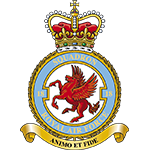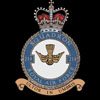RAF No 214 (Federated Malay States) SquadronRAF No 214 (Federated Malay States) Squadron
Motto: Ulter in umbris (Avenging in the shadows)
No 14 (Naval) Squadron had been formed at Coudekerque on 28 July 1917 as No 7A Squadron, adopting the number 14 on 9 December 1917. Equipped with the Handley Page O/100 bomber, it became No 214 Squadron on the formation of the RAF on 1 April 1918. It was involved in carrying out bombing attacks against enemy strategic targets in Belgium and Northern France. It received the O/400 in June 1918, continuing in this role until the end of the war. In July 1919, the squadron moved to Egypt but disbanded on 1 February 1920 by being absorbed into No 216 Squadron.
The squadron reformed on 16 September 1935 from a nucleus provided by 'B' Flight of No 9 Squadron at Boscombe Down. It was still in the night bomber role, equipped with the Vickers Virginia X. A move to Scampton was followed by re-equipment with Harrows in January 1937 and further re-equipment with Wellingtons in May 1939. It operated various models of Wellington on night raids as part of Bomber Command's main force until April 1942. The squadron re-equipped with the Stirling and continued in the same role until January 1944.
However, at this point the squadron underwent a major change in both equipment and role. It was now equipped with Fortress II and III aircraft, which were specially modified for the electronic counter-measures role. In this role the squadron was part of No 100 Group and it continued to carry out a wide range of ECM duties until the end of the war, disbanding on 27 July 1945. Almost immediately No 614 Squadron in Italy was re-numbered 214 and in August, it took its Liberators to Palestine but on 15 April 1946, it was disbanded again by being re-numbered No 37 Squadron.
Later that year, on 4 November , the squadron reformed at Upwood as a bomber unit, initially equipped with the Lancaster B 1(FE), but in February 1950 these were replaced with Lincolns. During this period the squadron saw 'active' service when a detachment was sent to Kenya to operate against 'Mau-Mau' terrorists, before disbanding again on 30 December 1954. The squadron briefly reformed at Laarbruch on 15 June 1955 as a Canberra PR Mk 7 equipped photo-reconnaissance unit. However, it career in this role was brought to an end less than two months later, when on 1 August, it was renumbered as No 80 Squadron.
It reformed once again on 21 January 1956 as part of the V-Force, equipped with the Valiant. These were used in action during Operation Musketeer, the Anglo-French Suez campaign. In 1958 it became the first squadron in the RAF to operate air-to-air refuelling tankers, a role it remained in for the rest of its service life. During this period it undertook many long distance flights to prove the operational worth of the system, setting many new world records in the process. However, the failure of the main spars on some Valiants brought the useful life of these aircraft to a premature end and the squadron disbanded on 28 February 1965.
When new equipment became available, No 214 was reformed, on 1 July 1966 at Marham. It was now equipped with an air-to-air refuelling version of the Victor, which continued to operate until its final disbandment on 28 January 1977. During this period it provided a valuable service to both fighter and strike units of the RAF during deployments and exercise.
Standards:
Award of Standard originally announced on 10 Oct 1961, effective from 1 Apr 1961 but presented:-
Battle Honours:
Western Front, 1917-18: Biscay Ports, 1940-44: German Ports, 1940-45: Ruhr, 1940-45: Fortress Europe, 1940-44: Invasion Ports, 1940: Berlin, 1940-45: Channel & North Sea, 1942-44: Baltic, 1942-44: Normandy, 1944: France & Germany, 1944-45:
Squadron Codes used: -
214 Jan 1937 - Apr 1939
UX Apr 1939 - Sep 1939
BU Sep 1939 - Jul 1945
QN, PX* Nov 1946 - Apr 1951 (*only used by 'C' Flt)

 Editor for Asisbiz: Matthew Laird Acred
Editor for Asisbiz: Matthew Laird Acred
If you love our website please subscribe to our YouTube video channel
Please donate so we can make this site even better !!

